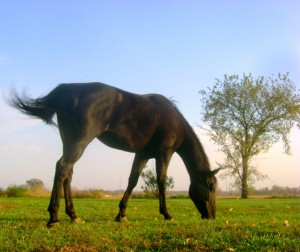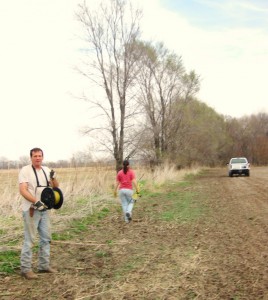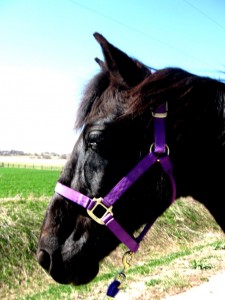 Here in the midwest things are changing. It’s unbelievable what a week’s worth of rain can do for the dried up roots of winter….everything in Iowa is magically green! Our horses are anxiously awaiting turnout, greeting me with whinnies whenever I appear. I love watching them canter out to graze, usually bucking or tossing their heads as they run, showing their exuberance for the freedom spring brings.
Here in the midwest things are changing. It’s unbelievable what a week’s worth of rain can do for the dried up roots of winter….everything in Iowa is magically green! Our horses are anxiously awaiting turnout, greeting me with whinnies whenever I appear. I love watching them canter out to graze, usually bucking or tossing their heads as they run, showing their exuberance for the freedom spring brings.
With the arrival of spring comes fresh green grass and also some precautions for turning horses out on it. If your horses have been stalled or on dry lot all winter, you need to be very careful when introducing them to new spring grass. The lush new growth of spring grass is extremely rich in nutrients and can trigger laminitis or colic. You can prevent the chance of illness by monitoring how much access your horse has to the grass until his digestive system is accustomed to it. If you notice any signs of founder–sore feet, crested necks, puffy deposits in the horse’s rump, get him to a vet as soon as possible. Here are a few tips for keeping your horse healthy through spring:
If grass in your pasture is overly lush, it is a good idea for the horse to have some hay in its belly prior to turnout each day, so feed hay as usual and then turn him out for 30 minutes up to an hour. Double the turnout time each week, starting in small increments and building up to full-time or whatever your summer turnout routine is. Or if grass has not come in fully yet, you can turnout and supplement with free-choice hay. The horse will continue to eat hay to balance out his diet, and not overfill on the new spring grass. Other options are strip grazing (sectioning off parts of the pasture with electric tape fencing so only some of the grass is accessible to the horse) or a grazing muzzle which hinders the horse’s ability to take in large amounts of forage.
Spring also brings a checklist of things to be done before turning your horses out. Check all fences for safety, clean up the fields, and burn fallen branches or leaves. Clean and fill water tanks, check run-in shelters for roof leaks or repair needs, and get everything horse-proof. Spring is a great time to update your horse’s vaccinations and deworming, and the warmer weather brings more opportunities to pamper your horse too, so get your shedding blades ready!
 Cowboy Dad and I went around the horse pasture yesterday, tightening the fence, straightening crooked t-posts, and making sure the electric tape we have running along the insides of the fence wasn’t tangled or shorting out anywhere. We use the electric fence for added security along the wire fence, as it keeps the horses from pushing against the wires to reach for grass on the other side and getting hurt or tangled in the fencing. It doesn’t take much for a horse to hurt itself, and it’s well worth the trouble of stringing some electric tape and hooking up a solar powered charger.
Cowboy Dad and I went around the horse pasture yesterday, tightening the fence, straightening crooked t-posts, and making sure the electric tape we have running along the insides of the fence wasn’t tangled or shorting out anywhere. We use the electric fence for added security along the wire fence, as it keeps the horses from pushing against the wires to reach for grass on the other side and getting hurt or tangled in the fencing. It doesn’t take much for a horse to hurt itself, and it’s well worth the trouble of stringing some electric tape and hooking up a solar powered charger.
 And as usual, when the work is done there’s a little time for riding. I rode Genesis, our Tennessee Walker gelding, around the farm bareback a little bit. He is so fun to ride—he’s very fast and smooth and high-powered. I have always liked a horse with no lazy tendencies, and Genesis certainly suits me in that regard. He is a little buddy sour, and will generally head for the barn with every open opportunity, but when corrected with rein and a little leg pressure he lines out and responds well. I need to spend a lot more time with him to work on that, because it makes him unsuitable for a beginner’s horse, and he has so much potential as a beginner’s horse! So I’d really like to get him over that buddy thing.
And as usual, when the work is done there’s a little time for riding. I rode Genesis, our Tennessee Walker gelding, around the farm bareback a little bit. He is so fun to ride—he’s very fast and smooth and high-powered. I have always liked a horse with no lazy tendencies, and Genesis certainly suits me in that regard. He is a little buddy sour, and will generally head for the barn with every open opportunity, but when corrected with rein and a little leg pressure he lines out and responds well. I need to spend a lot more time with him to work on that, because it makes him unsuitable for a beginner’s horse, and he has so much potential as a beginner’s horse! So I’d really like to get him over that buddy thing.
I’m just giving a big sigh of relief that winter has passed and there are warm days ahead. We’ll be knee-deep in mud for a little while longer, but the green will prevail. It’s my favorite color—spring green—and I just have to dedicate this entire post to how happy I am to see the world greening up again!
Enjoy a happy springtime with your horses!
